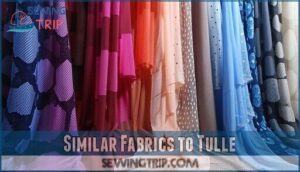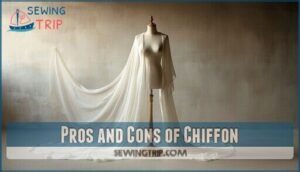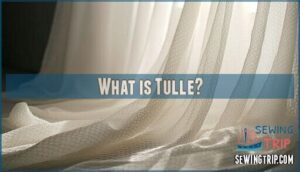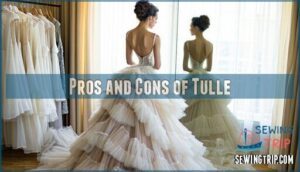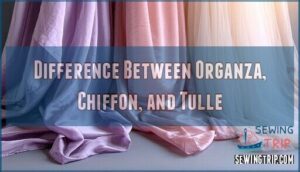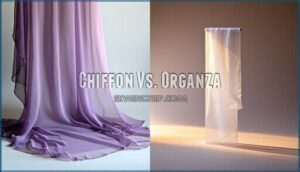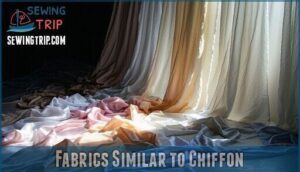This site is supported by our readers. We may earn a commission, at no cost to you, if you purchase through links.
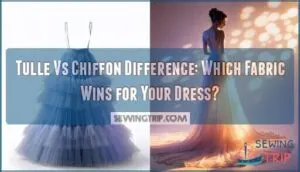 The tulle vs chiffon difference comes down to structure and feel.
The tulle vs chiffon difference comes down to structure and feel.
You’ll find tulle has a stiff, net-like texture that creates volume and holds its shape—think princess ball gowns with that dramatic poof.
Chiffon flows like water with its soft, sheer weave that drapes beautifully against your body.
Tulle’s hexagonal mesh gives it bounce and structure, while chiffon’s plain weave creates fluid movement.
If you want structured drama, tulle’s your friend.
For graceful, romantic flow, chiffon wins.
Both are sheer, but they behave completely differently on your body.
The choice between them can transform your entire silhouette.
Table Of Contents
- Key Takeaways
- Differences Between Tulle and Chiffon
- Chiffon Vs. Tulle – Wedding Dress
- Chiffon Vs. Tulle – Veil
- Similar Fabrics to Tulle
- Pros and Cons of Chiffon
- What is Tulle?
- Pros and Cons of Tulle
- Difference Between Organza, Chiffon, and Tulle
- Chiffon Vs. Organza
- Fabrics Similar to Chiffon
- Frequently Asked Questions (FAQs)
- Conclusion
Key Takeaways
- You’ll get structured volume with tulle’s mesh construction – It holds its shape beautifully for dramatic ballgowns and princess silhouettes, while chiffon flows like water with soft, graceful movement that flatters your natural curves.
- Your fabric choice transforms your entire look – Tulle creates show-stopping drama through its hexagonal mesh that maintains structure, while chiffon delivers romantic elegance with its plain weave that drapes fluidly against your body.
- You’re choosing between durability and delicacy – Tulle’s sturdy mesh resists snagging and maintains shape better than chiffon’s fragile nature, though both require gentle care and handling during construction and cleaning.
- Your wedding dress style determines the winner – Pick tulle for ballgown volume and structured support, or choose chiffon for A-line and sheath styles that need flowing movement and breathable comfort for outdoor ceremonies.
Differences Between Tulle and Chiffon
Two distinct fabric personalities emerge when comparing tulle vs chiffon for your dream dress.
Chiffon fabric flows like liquid silk with its smooth weave, while tulle fabric creates structured volume through its mesh construction.
Chiffon whispers elegance through flowing movement, while tulle boldly declares drama with structured mesh magic.
The fabric composition differs substantially—chiffon uses simple weaves from silk or synthetic fibers, whereas tulle features netted patterns.
Their drape comparison reveals chiffon’s fluid movement versus tulle’s crisp hold.
Transparency levels vary, with both offering sheer qualities but different visual effects.
Tulle characteristics include firmness and shape retention, while chiffon characteristics emphasize softness and graceful movement.
Durability factors favor tulle’s sturdy mesh over chiffon’s delicate nature.
For similar applications, consider the crispness of voile as an alternative.
Chiffon Vs. Tulle – Wedding Dress
When choosing between tulle vs chiffon for your wedding dress fabric, you’re picking between structure and flow.
Chiffon fabric creates that dreamy, romantic silhouette highlighting your natural curves with its superior drape comparison. It’s perfect for beach weddings due to excellent weather suitability, keeping you cool and comfortable.
Tulle fabric excels at dress fullness, creating those dramatic ballgown moments you’ve dreamed of. It holds its shape beautifully, giving you that princess-worthy volume.
However, alteration difficulty varies substantially between these wedding dress options. Both fabrics are known for being lightweight, but chiffon is especially known for its airy feel.
| Feature | Chiffon | Tulle |
|---|---|---|
| Movement | Flows gracefully | Holds structure |
| Best Style | A-line, sheath | Ballgown, princess |
| Comfort Level | Lightweight, breathable | Structured, supportive |
Your wedding dress choice ultimately depends on whether you want flowing elegance or structured drama for your special day.
Chiffon Vs. Tulle – Veil
Wedding veils transform brides into ethereal visions, but choosing between tulle vs chiffon determines your bridal moment’s magic.
| Feature | Tulle Fabric | Chiffon Fabric |
|---|---|---|
| Veil Texture | Structured mesh with visible holes | Smooth, flowing weave |
| Veil Durability | Maintains shape, resists snagging | Delicate, prone to damage |
| Veil Opacity | Multiple transparency options | Subtle, soft sheerness |
Tulle’s firmer structure holds veil embellishments like pearls or crystals beautifully. You’ll find it perfect for shorter shoulder-length styles that need volume.
Chiffon’s liquid drape creates romantic movement for floor-length veils, though it’s less stable than tulle. As a result, chiffon is often chosen for flowing dresses and veils.
Veil length matters when selecting wedding dress fabric. Lace-edged tulle offers classic appeal, while raw chiffon edges require trimming to prevent fraying. Your choice affects both visual impact and long-term preservation.
Similar Fabrics to Tulle
Beyond tulle, several mesh fabrics offer similar structure and elegance for your special day.
Each brings unique characteristics that might better suit your vision.
Here’s your netting comparison guide:
- Bobbinet fabric – Features hexagonal holes without stretch, perfect for structured silhouettes
- Maline fabric – Diamond-shaped mesh with medium stretch for flattering drape
- Fishnet alternatives – Larger, irregular holes with more stretch for fitted designs
- Point desprit – Embroidered dots on mesh for vintage millinery charm
While organza provides crisp structure, these mesh options deliver tulle’s ethereal quality with different textures and flexibility levels.
It’s available at various online retailers.
Pros and Cons of Chiffon
You’ll find chiffon offers beautiful drape and an ethereal appearance that’s perfect for formal wear.
But it comes with significant handling challenges that can frustrate even experienced sewers.
Understanding chiffon’s strengths and weaknesses helps you decide whether this delicate fabric matches your project’s needs and your sewing skill level, considering its delicate nature.
Pros
Since chiffon fabric offers incredible versatility, you’ll find it perfect for everything from wedding gowns to evening scarves.
The lightweight material provides exceptional comfort while maintaining breathtaking aesthetics that flow beautifully with your movements.
Cost effectiveness makes chiffon an attractive choice compared to premium silk options.
When considering fabric comparison with tulle fabric, chiffon’s eco-friendliness shines through its biodegradable silk varieties.
These chiffon uses deliver stunning results for your special occasions.
Cons
You’ll discover chiffon fabric presents several challenges that test your sewing skills and patience.
Working with chiffon is like taming silk butterflies—beautiful results require delicate hands and endless patience.
- Snagging Issues plague this delicate material, tearing easily from jewelry or rough handling during construction.
- Fraying Problems emerge at cut edges, requiring immediate seam finishing to prevent unraveling.
- Wrinkling Challenges make pressing difficult without damaging the gossamer fibers.
- Cleaning Difficulty demands specialized care to maintain fabric integrity.
What is Tulle?
Originally created in the French city of Tulle during the late 18th century, tulle origins trace back to handcrafted silk netting.
This distinctive mesh fabric features tulle construction with hexagonal openings formed by twisted threads. Unlike smooth fabrics, tulle’s netted structure creates volume and holds shape beautifully.
You’ll find tulle variations ranging from soft silk to sturdy nylon, each offering different tulle textures. Common tulle applications include wedding veils, ballet tutus, and formal gowns.
Similar fabrics like bobbinet share tulle’s mesh characteristics, making tulle uses versatile across fashion and costume design.
Pros and Cons of Tulle
Tulle brings both magic and challenges to your wedding dress dreams. This mesh fabric’s unique structure creates stunning volume while maintaining surprising lightness at just 0.5 ounces per square yard.
Tulle’s advantages shine through:
- Tulle Versatility lets you create dramatic ball gowns, delicate veils, or layered underskirts with equal success
- Tulle Cost remains budget-friendly, with polyester versions ranging from $2-$10 per yard
- Tulle Stiffness provides excellent shape retention, holding your gown’s silhouette without sagging
- Tulle Durability surpasses chiffon’s fragility, though it’s still delicate compared to cotton fabrics
- Wide color selection guarantees perfect matching for any wedding theme
However, Tulle Comfort poses challenges. The mesh texture can irritate sensitive skin, especially around the neckline or arms. You’ll also need gentle care during cleaning and storage. Despite these drawbacks, tulle’s ability to transform simple designs into show-stopping gowns makes it invaluable for creating your perfect wedding dress moment.
Difference Between Organza, Chiffon, and Tulle
When you’re choosing between organza, chiffon, and tulle for your dress, understanding their unique characteristics will save you from fabric frustration later.
These three popular fabrics differ substantially in texture, drape, structure, and durability, making each one perfect for specific dress styles and occasions.
Appearance
When comparing fabric opacity and texture, chiffon’s whisper-thin transparency creates an ethereal, flowing appearance that catches light beautifully.
Tulle’s distinctive mesh structure offers visual volume through its netted weave, providing more coverage than chiffon’s sheer layers.
The texture comparison reveals chiffon’s smooth surface detail versus tulle’s structured hexagonal pattern, with different sheerness levels affecting light reflection and overall garment silhouette dramatically.
Durability
When choosing between these delicate fabrics, durability becomes your practical guide.
Here’s how each fabric holds up:
- Tear Resistance – Tulle’s mesh structure handles stress better than chiffon’s loose weave
- Stain Resistance – Tulle repels spills while chiffon fabric absorbs marks permanently
- Shape Retention – Tulle maintains structure through wear, unlike flowing chiffon
- Cleaning Methods – Both require gentle care, but tulle survives handling better
- Longevity Comparison – Polyester tulle outlasts silk chiffon substantially
While chiffon appears sturdy, tulle wins the fabric durability contest for long-term wear.
Breathability
Both tulle and chiffon excel at fabric ventilation, making them perfect lightweight fabrics for warm weather events.
Chiffon’s loose weave density allows excellent airflow while providing minimal moisture wicking properties.
Tulle’s mesh structure creates superior breathability through its open construction.
These sheer fabrics offer exceptional seasonal comfort without heavy layering effects, keeping you cool during summer ceremonies and receptions.
Fit and Drape
When choosing between these fabrics, you’ll notice how each one shapes your silhouette differently.
Chiffon’s flowing drape creates elegant lines that highlight your body’s natural curves, while tulle’s structured mesh provides excellent volume control for fuller skirts.
- Fabric Flow: Chiffon moves gracefully with every step you take
- Structured Silhouettes: Tulle maintains shape without additional support
- Volume Control: Tulle creates dramatic fullness; chiffon offers subtle movement
- Draping Techniques: Layer both fabrics for balanced texture and dimension
Feel
Your fingertips reveal each fabric’s true personality through tactile qualities and sensory experience.
Chiffon’s silky texture glides across skin like butter, offering superior comfort level during extended wear.
Tulle texture delivers structured support but can feel scratchy against bare skin contact.
As opposed to chiffon, tulle’s texture isn’t very breathable, but organza allows airflow.
| Fabric | Texture | Skin Contact |
|---|---|---|
| Chiffon | Silky smooth | Gentle, comfortable |
| Tulle | Mesh-like, stiff | Can irritate sensitive skin |
Understanding fabric hand helps you choose wisely for your special day, considering the sensory experience and comfort level of each fabric, which is crucial for making an informed decision, and ultimately, achieving the perfect silky texture.
Chiffon Vs. Organza
When you’re weighing organza against chiffon, fabric stiffness becomes your deciding factor.
Organza’s crisp weave structure stands firm while chiffon flows like water through your fingers.
| Feature | Chiffon | Organza |
|---|---|---|
| Fabric Stiffness | Soft, fluid drape | Structured, holds shape |
| Sheerness Comparison | Very transparent | Semi-sheer to opaque |
| Cost Analysis | Moderate pricing | Higher cost typically |
These lightweight fabrics serve different purposes.
Chiffon’s romantic softness suits flowing gowns, but organza’s durability makes it perfect for structured overlays and home décor.
Your best uses depend on whether you want dreamy movement or architectural precision.
Both sheer fabrics offer elegance, but organza won’t leave you wrestling with slippery material during alterations.
Chiffon, known for its breathability, is ideal for warmer climates.
Fabrics Similar to Chiffon
Several fabrics capture chiffon’s dreamy essence while offering better durability.
Georgette fabric stands out as your best bet – it’s slightly heavier than chiffon with a subtle crinkled texture that won’t snag as easily.
Silk alternatives like crepe de chine provide that luxurious drape you’re after without the headaches.
Poly chiffon and rayon chiffon deliver budget-friendly options that mimic silk’s luminosity.
These lightweight fabrics offer similar transparency and flow while being more forgiving during construction.
For extra structure, organza brings crispness to your designs, though it’s stiffer than traditional chiffon texture.
When working with these sheer fabrics, handle them like precious cargo.
Keep your iron on low heat and avoid stress points during sewing.
Each fabric brings its own personality to your project while giving you that ethereal look you’re craving.
Frequently Asked Questions (FAQs)
How Do You Care for and Clean Tulle and Chiffon Fabrics?
Hand-wash both fabrics in cool water with gentle detergent.
Don’t wring or twist them. Air-dry flat on towels.
For wrinkles, use low-heat steam or pressing cloth.
Store hanging to prevent creasing.
Where Can You Buy Affordable Tulle and Chiffon Fabric?
You’ll find affordable tulle and chiffon at fabric stores like Joann’s, Mood Fabrics, or Fabric.com.
Check clearance sections, use coupons, and compare prices online.
Local craft stores often have sales too.
How Do You Prevent Snags and Runs in Delicate Chiffon Fabric?
Nearly 80% of chiffon damage occurs from jewelry snags.
You’ll want to remove rings and bracelets before handling the fabric.
Use sharp scissors for clean cuts, store pieces flat in tissue paper, and always sew with fine needles.
How do you care for and clean tulle and chiffon fabrics?
You’ll want to hand-wash both fabrics in cool water with gentle detergent.
Skip the wringing—just press water out softly.
Air-dry flat, then use low-heat iron with pressing cloth for best results.
Where can you buy affordable tulle and chiffon fabric?
Craft stores like Joann’s and Michaels offer budget-friendly options.
Online retailers including Amazon, Fabric.com, and Etsy provide competitive prices.
Thrift stores sometimes carry these delicate materials, while warehouse sales offer designer remnants affordably.
How do you prevent snags and runs in delicate chiffon fabric?
Handle chiffon gently with clean, dry hands.
Store it flat or loosely folded to avoid creasing.
Use sharp scissors for cutting, keep jewelry away while wearing, and wash in mesh bags with cold water.
How to wash tulle and chiffon properly?
Picture your delicate fabrics floating like clouds in gentle soapy water.
Hand-wash both tulle and chiffon in cool water with mild detergent, squeeze gently without wringing, then lay flat to air-dry away from direct sunlight.
This ensures that your fabrics are cleaned and dried with the utmost care, preserving their delicate nature.
Which fabric is better for beginners sewing?
Choose tulle for your first project.
It’s more forgiving than chiffon, holds its shape better, and won’t snag as easily.
Chiffon’s slippery texture and fragile nature make it challenging for beginners to handle.
Can tulle and chiffon be dyed easily?
Dreaming of transforming your fabric into vibrant colors?
You can dye both tulle and chiffon, but synthetic versions resist color better than natural fibers.
Silk takes dye beautifully while polyester needs special techniques.
What needle size works best for each?
You’ll want a size 70/10 or 80/12 universal needle for chiffon’s delicate weave, while tulle handles a slightly larger 80/12 or 90/14 needle better due to its mesh structure and firmer texture.
Conclusion
Mastering the tulle vs chiffon difference will revolutionize your dress selection forever.
You’ve discovered tulle’s structured drama creates stunning volume while chiffon’s fluid grace delivers romantic elegance.
Choose tulle when you want that show-stopping ballgown silhouette that commands attention.
Pick chiffon for flowing, ethereal movements that flatter your figure naturally.
Understanding each fabric’s unique personality means you’ll never second-guess your choice again.
Your perfect dress awaits—now you know exactly which fabric delivers your dream look.
- https://en.wikipedia.org/wiki/Tulle_(netting)
- https://english.stackexchange.com/questions/454417/each-layer-or-each-layers
- https://pubs.rsc.org/en/content/articlelanding/2015/cp/c5cp00154d
- https://www.eachstephome.org/
- https://www.awin1.com/cread.php?awinmid=6091&awinaffid=258957&ued=https%3A%2F%2Fwww.etsy.com%2Fmarket%2Fbobbinet

